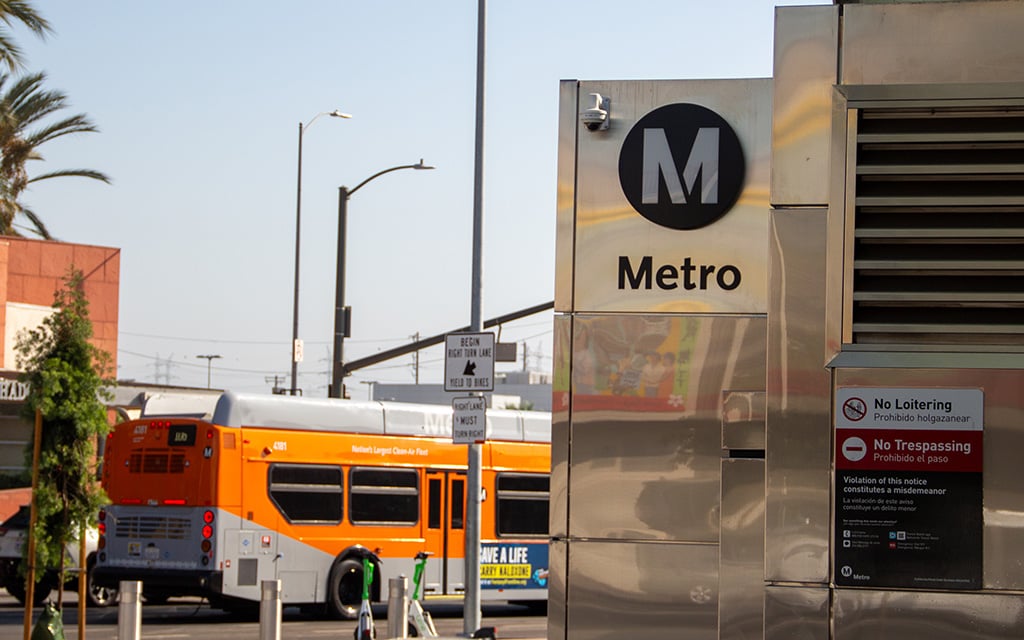LOS ANGELES – Ahead of the 2028 Olympic Games, the City of Angels is already preparing for its turn with the torch by improving public transport in support of a “transit-first” Games.
“Public transportation will be the best option for spectators to take because it will be built into the Games plan to serve as the most reliable and efficient way to get to your destination while minimizing traffic in highly congested areas,” Sam Morrissey said in a statement. Morrissey is vice president of transportation for LA28, the Games’ organizing committee.
Additional public transportation will not only benefit spectators of the Games but also Southern California residents.
“The 2028 Olympics will be a time bustling with people from all over, no doubt bringing thousands of people,” City Councilwoman Heather Hutt said in a statement. “By increasing public transportation, we can limit some of the stressors with traffic that we all face while using our streets.”
The Los Angeles County Metropolitan Transportation Authority, or Metro, created a list called “Twenty-eight by ’28,” which describes all the transportation changes scheduled to be complete before the Games.
So far, 18% of the projects are complete – all rail-related – while 32% are under construction and half are in design or planning stages. Other projects include switching some gas-powered buses to electric, increasing biking or walking paths to better connect stations and expanding highways to allow more room for trucks and carpool lanes.

Of the projects on LA Metro’s “Twenty-eight by ’28” list, 12 of the initiatives are rail-related, with five already completed. Photo taken on Oct. 3, 2024 in Los Angeles. (Photo by Emery Davis/Cronkite News)
“We are focusing on providing legacy and permanent benefits after the 2028 Games to encourage shift to sustainable transportation modes, improve safety, increase accessibility and improve customer experience,” Metro’s website says.
One traffic stress solution for the Games and beyond is a City of Inglewood project, the Inglewood Transit Connector (ITC). The 1.6-mile fixed-guideway transit system will have a station near the K Line to take riders to two proposed Olympic venues – Intuit Dome and SoFi Stadium – that are expected to host basketball and swimming, respectively.
In addition to the push for public transportation use and implementing electric railway system upgrades in support of the environment, using pre-existing venues for the Games is another way LA28 plans to show its green thumb.
Though the Inglewood project is designed to address transportation challenges for the Games, the project is expected to have a long-term impact since the Downtown Inglewood Station lacks walkability to a large portion of the city.
“The ITC Project’s fully-elevated, electrically-powered, automated transit system will address this critical first/last mile gap and provide a direct connection between the Greater Los Angeles region and the Los Angeles Sports and Entertainment District – an employment and visitor hotspot,” according to the website of Envision Inglewood, a mobility improvement plan made up of several infrastructure initiatives.
In addition to minimizing street traffic from personal vehicles, the transit-first approach will allow for a more sustainable Olympic Games. Another solution is a bus fleet with designated bus-only lanes specifically for Games transportation.
“LA28 is looking to repeat and expand upon the transportation success of the LA84 Games, while taking a few learnings from the 1996 and 2002 Games as well,” Morrissey said in a statement. “The federal government provided support for supplemental bus programs to move spectators at the 1996 and 2002 Games, and we’re requesting similar support for 2028.”
Darrell Clarke of the Sierra Club said despite their larger sizes, buses are a more sustainable choice than personal vehicles.
“If they fill the buses, it’s better (for the environment),” Clarke said. “If you have a lot of buses filled with people, that’s making good use of the diesel.”

Los Angeles buses, railways and foot paths are on track to see improvements for the 2028 Olympic Games. Photo taken on Oct. 3, 2024. (Photo by Emery Davis/Cronkite News)
Clarke is the chair of transportation for the club’s Angeles Chapter, which is composed of members from Los Angeles and Orange counties. He has an extensive background in transportation and has worked closely with the rail systems that are being modified.
Clarke is supportive of the extension and said the Hollywood area is busy enough to benefit from the project.
“I think the subway projects make a whole lot of sense when you have that kind of density,” Clarke said. “It’s a way of getting around, and it’s faster than the alternative.”
With a plethora of projects to support the Games, Morrissey said LA28 hopes their plan of action will continue to benefit California residents beyond the Olympic Games.
“As the region’s public transportation network continues to expand and millions of people have a positive experience during the LA28 Games, it’s our hope that the Games can encourage more people to get in the habit of using Metro by making it a part of their everyday lives,” Morrissey said.

